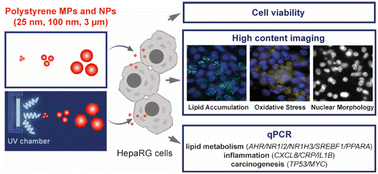Environmentally relevant UV-light weathering of polystyrene micro- and nanoplastics promotes hepatotoxicity in a human cell line†
Abstract
Background: micro- and nanoplastics (MPs/NPs) are global pollutants of concern to human health due to their increasing environmental accumulation and biopersistence. They can reach systemic circulation and distribute to organs, with the liver being a potential target due to its propensity to accumulate particles. However, knowledge of MP and NP hepatotoxicity is scarce and mostly focused on primary particles, which lack environmental relevance. Therefore, the aim of this study was to characterize how UV-weathering influences hepatic cell responses to polystyrene (PS) MPs and NPs. Results: we characterized the effects of primary PS MPs (3 μm) and NPs (25 and 100 nm) on a human liver cell line (HepaRG) by using high content imaging to profile alterations in pathologically relevant key cellular events, including oxidative stress, lipid accumulation, and nuclear morphology, as well as evaluating differential expression of genes relevant to lipid metabolism, inflammation, and carcinogenesis. We observed no changes in cell viability even at high concentrations (100 μg ml−1) or after prolonged exposure (10 days). However, after UV-induced weathering, PS particles induced cytotoxicity after 24 h at a concentration of 0.1 μg ml−1, which is <7% of PS particle concentrations detected in human blood. Other cellular stress responses were observed only upon exposure concentrations of UV-weathered particles more than four times the maximum concentration (12 μg ml−1) detected in human blood. Finally, genes involved in lipid metabolism, inflammation, and carcinogenesis were upregulated upon exposure to most of the tested MPs and NPs. Conclusions: UV-weathering of pristine PS MPs and NPs increases their hepatotoxicity. Cytotoxicity was more pronounced for micro-sized PS particles, but PS NPs induced the expression of genes relevant to the development or progression of fatty liver disease. The data demonstrate the relevance of accounting for effects of weathering on the properties and biological impacts of MPs and NPs and emphasize the need for further studies of chronic MP and NP exposure on tissue function and disease risk.



 Please wait while we load your content...
Please wait while we load your content...